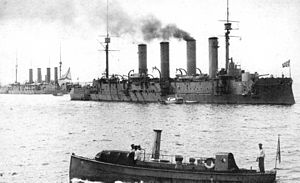Bayan-class cruiser

Admiral Makarov and Bayan at anchor, circa 1913
|
|
| Class overview | |
|---|---|
| Name: | Bayan |
| Operators: | |
| Preceded by: | Gromoboi |
| Succeeded by: | Rurik |
| Built: | 1899–11 |
| In commission: | 1902–20 |
| Completed: | 4 |
| Lost: | 1 |
| Scrapped: | 3 |
| General characteristics | |
| Type: | Armored cruiser |
| Displacement: | 7,750–7,802 long tons (7,874–7,927 t) |
| Length: | 449 ft 7 in (137.0 m) |
| Beam: | 71 ft 6 in (21.8 m) |
| Draft: | 22 ft (6.7 m) |
| Installed power: |
|
| Propulsion: | 2 shafts, 2 vertical triple-expansion steam engines |
| Speed: | 21 kn (39 km/h; 24 mph) |
| Range: | 3,900 nmi (7,200 km; 4,500 mi) at 10 knots (19 km/h; 12 mph) |
| Complement: | 573 |
| Armament: |
|
| Armor: |
|
The Bayan class was a group of four armored cruisers built for the Imperial Russian Navy around the beginning of the 20th century. Two of the ships were built in France, as Russian shipyards had no spare capacity. The lead ship, Bayan, was built several years earlier than the later three. The ship participated in several of the early naval battles of the Russo-Japanese War of 1904–05, and provided naval gunfire support for the Imperial Russian Army until she struck a mine. Bayan was trapped in harbor during the subsequent Siege of Port Arthur, and was sunk by Japanese artillery. She was salvaged and put into service with the Imperial Japanese Navy with the name of Aso. She mostly served as a training ship before she was converted into a minelayer in 1920. The ship was sunk as a target in 1932.
Her three sisters were all assigned to the Baltic Fleet. Pallada was the first ship lost by the Russians during World War I when she was sunk by a German submarine in October 1914. The two surviving ships were modified to lay mines, and participated in the Battle of Åland Islands in 1915 and the German invasion of the Estonian islands in 1917. They were decommissioned in 1918 and sold for scrap in 1922.
The Bayan class marked a departure from the previous Russian armored cruisers, as they were smaller ships designed to serve as scouts for the fleet rather than as commerce raiders. Authorized in the 1896–1902 building program, the design was outsourced to a French shipyard, Forges et Chantiers de la Méditerranée, because Russian shipyards were already at full capacity. Negotiations began in March 1897, and a contract was signed in May 1898 for one ship with delivery in 36 months.
...
Wikipedia
